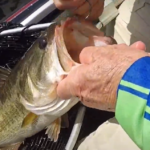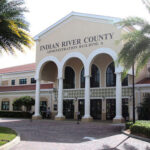The addition of a fishing component to the usual standard golf tournament has made Bass and Birdies one of the more challenging golf tournaments, but the players wouldn’t have it any other way. Adding the fishing twist was the brainchild of then Education Foundation board members Jay Campana and Lanse Padgett, and Joe Kern, Indian River Club’s head golf professional. “Joe and Lanse and I were sitting at the Sugar Shack. Joe said that the bass fishing had been really good and we thought – we ought to do something with that.” This is the fourth year for Bass and Birdies, held at the Indian River Club to benefit the programs and services of the Education Foundation of Indian River County.
In some ways the fishing portion of the game can even out the playing field as participants compete using both their golfing and angler abilities. If no fish are caught, a point is added to the golf score. On the other hand, points are taken off the golf score based on the number of fish caught (and released of course). The Club is an Audubon Signature Sanctuary with certain criteria which must be adhered to because of that distinction.
The basic premise (I won’t even attempt to go into the scoring) is that every player must actually cast a reel at two different fishing holes and must play golf at 16 holes. The fishing time allocated at each pond varies based on the length of time it will take to play the hole. Volunteers man each fishing spot, measuring the fish and keeping play moving along.
Some of the more advanced anglers bring their own gear, but rods and lures were supplied for the novices at each of the four fishing holes. Volunteer guides, including David Lyons and his son Chris, were also on hand to give a few pointers. “Chris is an avid fisherman; he’s helped a lot of people catch some really big fish today,” Lyons said proudly. “He just picked up fishing on his own and loves it.”
When I ran into Charles Croom on the course, he said he hadn’t yet caught any fish. Croom is a new Education Foundation board member, and this was his first year playing in the tournament. “We got skunked on the fishing front, but more importantly, we’re having fun.”
An awards party followed the tournament with cocktails and hors d’oeuvres and some great music by guitarist Terry Dobson. A live auction presided over by auctioneer George Blythe, included a Cozy Cottage get-a-way, donated by John and Lee Moore, a Link Lovers package, a Sports Lovers package and a Chef Dinner with Chef Joe Faria.
Fish tales abounded as players related their successes and lamented the big ones that got away. Dan Bockhorst told me that he’d caught three fish, with one of them being over 20-inches. “I don’t normally fish; that was the downfall for our group.”
A few players used the recent cold snap as an excuse for reeling in less than their normal catch. Still others echoed Chris Baggett, who admitted to not being much of a fisherman and said, “I usually buy my fish coconut encrusted.”
Avid angler Jay Campana caught 16 fish, which was more than any of the other players. “It’s a good tournament every year and the fishing makes for an exciting game. We’re all good friends; we’ve played four consecutive years.”
Randy Riley was non-committal when asked how he fared, saying simply with a smile, “It was a nice afternoon.”
Lynn Hall, who had chaired last year’s Bass & Birdies, was very pleased with the event. “It’s one of the most unique fundraising events; to be able to combine the two sports and to come to a club like this is fabulous. The support of the Indian River Club means a lot. These guys go out of their way to do this for us. To close the club on a weekend during season is very special.”
Bass and Birdies was chaired by Darren Sylvia, leading committee members Vinny Olmstead, Jose Prieto, Charles Croom, David Savage, Lynn Hall, Debbie Biedenharn, Dan Bockhorst and Bill Furr. The Education Foundation of Indian River County is unique as the only one in Florida that supports all schools in the county, public, private, parochial and charter, and 90% of its funding comes from private individuals and foundations.{igallery 136}






